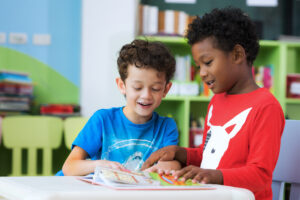The link between conversations & storytelling skills
A thought piece by Robbie – Certified Practicing Speech Pathologist.
Conversations.

While they may look different between a 3 year old and a 30 year old, conversations are how humans interact with each other and make meaningful connections.
But what makes a conversation successful?
We need language to have a conversation. More specifically, we need storytelling language to have a conversation.
Storytelling forms the basis of all conversations, and therefore social interactions.
From sharing a story about something that happened on the weekend, to recommending a TV show to a friend, to explaining the rules of a game – these are examples of how humans tell stories to converse and connect with others.
Children need storytelling language to share their ideas, recall stories, and create shared meaning with their communication partners. In other words, children need storytelling language to have conversations, and therefore engage in social interactions with their peers.
So as a Speech Pathologist, when I hear a parent say that their child is having difficulties engaging in social interactions, I wonder what that child’s conversations with their peers look like. More specifically, I wonder what their storytelling language looks like.
What might storytelling difficulties look like? When I think of storytelling difficulties, I think of breakdowns at the sentence and story structure level:

Sentence Level
- Difficulties with sentence structure (e.g. “the boy ice cream”)
- Use of nonspecific words (e.g. “they went there and they got on that thing”)
- Difficulties with verb tense (e.g. “they runned away and trip over”)
Story Structure Level
- Not providing context to a story (e.g. leaving out who is in the story, where and when it took place, what started the story)
- Leaving out key pieces of information
- Putting story events in the wrong order (sequencing difficulties)
- Finishing the story abruptly
- Difficulties starting a story (e.g. saying “I don’t know” in response to “what did you do at school today”)
Difficulties telling a story may impact a child’s ability to:
- Initiate an interaction with a peer
- e.g. saying where they want to play, and with who they want to play
- Maintain an interaction with a peer
- e.g. use of nonspecific language may lead to a communication breakdown
- Successfully convey their message
- e.g. difficulties sequencing ideas may lead to a communication breakdown
- Understand emotional vocabulary
- Process information from social interactions
- E.g. If a child omits information from their stories, they will likely not consider that information when processing a social event in their life, impacting how they interpret information from their social interactions
- Have a back and forth conversation with a communication partner
Where do Speech Pathologists come in?
Speech Pathologists can help children develop their storytelling skills by:
- Explicitly teaching story structure (beginning, middle and end)
- Supporting children to increase the length and complexity of their stories
- Supporting children to develop their language so they can use specific vocabulary in their stories
- Teaching children how to use storytelling as a way of processing information from their social interactions
- Teaching children how to use storytelling as a way of interacting with their peers

A real life example: The interaction between storytelling and social communication (conversations)
I was working with a student, let’s call him Tom. Tom’s parents reported that Tom was struggling to maintain friendships, and his friends would often walk away from him as they didn’t understand him.
When I spoke with Tom, he could formulate full sentences and he liked to make up stories. But because Tom was not yet providing context to his stories, I couldn’t understand his stories and as such, our conversations consisted of lots of communication breakdowns. I realised these breakdowns were occurring because Tom was not yet providing context to his stories. More specifically, he was not telling me who was in his story, where and when it took place and what started his story.
In therapy, Tom continued to make up stories about topics that interested him, but Tom and I found a story structure on which he could map his ideas. In particular, Tom and I practised introducing our characters, what their ‘powers’, weaknesses and motivations were, and where our story took place.
We practised identifying what had started his story and showing a cause and effect relationship between events using conjunctions (e.g. because, when, so). He learned to include dialogue between characters to role play different situations that related to his life through the lens of a fictional character.
Now, when Tom tells a story, he includes clear context to his story. At school, his friends now understand his messages, and he is able to engage in conversations with his peers. Importantly, as a point of celebration, Tom’s parents report he now has a close group of friends with whom he plays everyday.
When supporting a child’s storytelling language, the goal of therapy isn’t to change what a child wants to talk about. The goal is to provide them with ‘tools’ to successfully tell their stories and therefore, have conversations and engage in social interactions with their peers.
Written by Robbie Corgat
Certified Practicing Speech Pathologist

